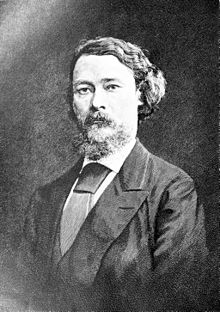
Koenig was born in Königsberg (Province of Prussia), and studied at the University of Königsberg in his native town.
About 1852 he went to Paris and in 1858 he started business on his own account. He called himself a "maker of musical instruments," but the instrument for which his name is best known is the tuning fork. Koenig's work speedily gained a high reputation among physicists for accuracy and general excellence. From this business Koenig derived his livelihood for the rest of his life. One of his last catalogs had 262 different items.
In the 1860s, the Koenig sound analyzer revolutionized musical and scientific worlds by demonstrated visually that musical notes and voices were in fact made up of simple sounds.[1]
Koenig's manometric flame apparatus (1862), used to visualize sound waves. Air pressure from an acoustic phone altered the flame provided by a Bunsen gas flame, which was amplified by a rotating mirror and recorded
Koenig will also be remembered as the inventor and constructor of many other beautiful pieces of apparatus for the investigation of acoustical problems, among which may be mentioned his wave-sirens, the first of which was shown at Philadelphia in 1876. His original work dealt, among other things, with Wheatstone's sound-figures, the characteristic notes of the different vowels, a manometric flame apparatus, a vibration microscope, among others; but perhaps the most important of his researches are those devoted to the phenomena produced by the interference of two tones, in which he disputed the views of Helmholtz as to the existence of summation and difference tones.
He died in Paris.
